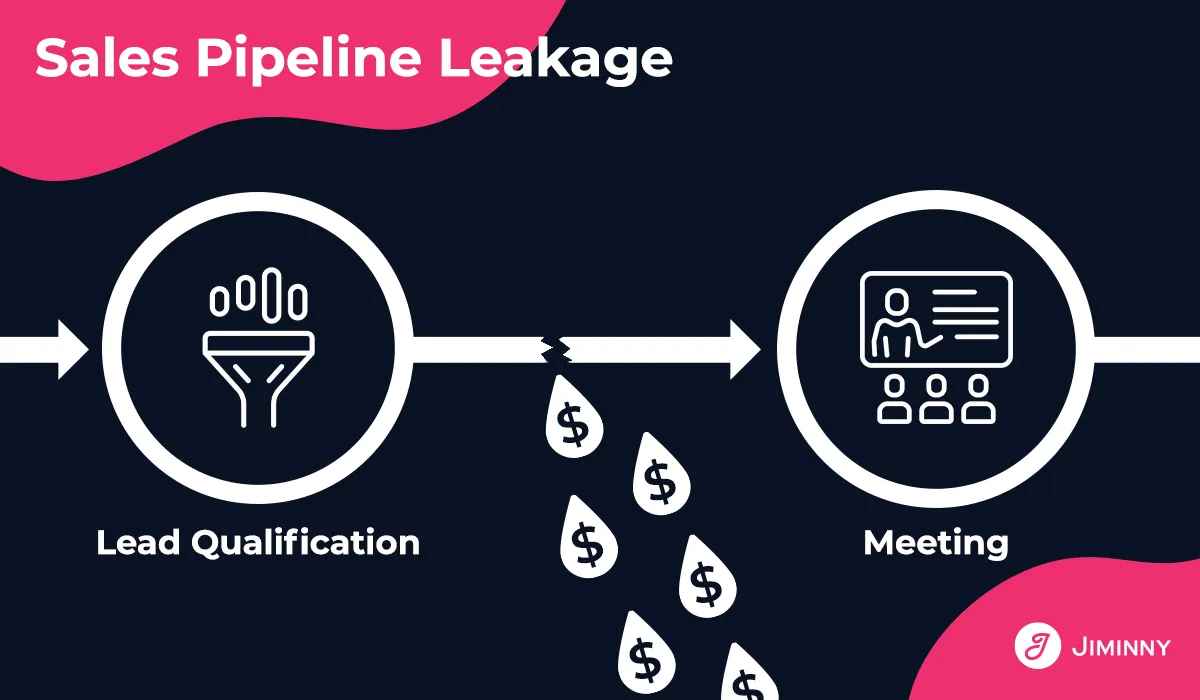60-Second Summary
Sales pipeline leakage - the gap between prospects entering the pipeline and deals successfully closing - is one of the biggest causes of missed quotas and revenue loss. Pipeline leakage occurs when prospects drop out due to poor qualification, weak lead nurturing, lack of coaching, or capacity issues. Sales Leaders, GTM Engineers and RevOps professionals must track leakage using clear benchmarks: overall conversion rates, rep-level performance, segment breakdowns, and prospect sources. Warning signs include declining conversion rates, inaccurate forecasting, and lengthening sales cycles. To fix leaks, strengthen prospect qualification, improve lead quality, provide consistent coaching, and refine sales definitions across your team. Benchmarking by market segment and deal size helps pinpoint problem areas, while sharing best practices across high-performing reps ensures consistency. Ultimately, preventing pipeline leakage requires ruthless honesty - cutting weak opportunities, doubling down on high-potential accounts, and ensuring alignment across Sales, Marketing, and RevOps. Done right, this reduces wasted resources, improves forecasting, boosts morale, and maximizes revenue.
Grab your waterproofs and your spanner - it’s time to find and plug the gaps in your sales process.
What is sales pipeline leakage?
Sales leakage is the gap between the number of prospects entering your sales pipeline and the number of deals exiting the pipeline.
While you may be keeping a close eye on your final pipeline conversion rate, pipeline leakage may be happening in other areas. And its causes may be scattered throughout your sales process, for more subtle or complex reasons than your rep having a bad day.

Pipeline leakage is one of the biggest causes of missed targets and revenue shortfalls. Here, we'll break down the fundamentals of pipeline leakage and provide tips for diagnosing it.
Reality check 1: pipeline leakage vs. revenue leakage
Before we move forward, let's clarify a common misconception: in sales, pipeline leakage and revenue leakage are not the same thing. But the terms are often used interchangeably.
Sales pipeline leakage is all about prospects that don't convert into paying customers. On the other hand, revenue leakage occurs when customers don't pay the full amount they owe you as a supplier, often due to errors in billing and admin.
Don't confuse these two leaks; they have different origins and require distinct strategies to fix.
Reality check 2: sales funnel vs. sales pipeline
The second important thing to get clear is that not everything in the funnel is meant to convert.
Your sales funnel includes all potential prospects, but not all of them will make it to your sales pipeline. The sales pipeline is where the real action happens, where you focus your efforts on visible opportunities that have a genuine chance of becoming customers. Don't be disheartened if some prospects drop out of the funnel; it's a natural and essential part of the funneling process.
When considering pipeline leakage, remember this distinction and get hot on your sales funnel and sales pipeline reporting.
How to calculate sales pipeline leakage
First, subtract the number of closed deals from the total prospects entering the pipeline. In this case, closed deals refer to either Closed/Won or Closed/Lost where you have a real reason documented for a loss.
Then, divide the result by the total prospects and multiply by 100 to get the percentage. The formula looks like this:
Leakage percentage = [(total prospects - closed deals) / total prospects] * 100
For example, if you had 100 prospects entering the pipeline and either Closed/Won or Closed/Lost 80 deals, your leakage would be:
Leakage percentage = [(100 - 80) / 100] * 100 = 20%
Reasons for pipeline leakage
Now that we know what pipeline leakage is and how to calculate it, let's dig into some possible reasons why it happens. There are several culprits lurking in the shadows of your sales process. And any number of them could be causing your issues.
It's important to remember here that every sales pipeline is different, so while there are common themes between leaking pipelines, diagnosing yours will be unique to you.
#1 Poor prospect qualification and prioritization
Not all prospects are created equal. If your team is chasing down leads that aren't a good fit for your product or service, you're setting yourself up for leakage (not to mention some pretty burnt-out reps). Properly qualifying and prioritizing prospects can ensure that you're focusing your efforts on the most promising opportunities.
#2 Lack of team capacity
Sometimes, it's a matter of manpower. If your sales team is overwhelmed with too many prospects, they might not be able to give each one the attention it deserves. This can lead to missed opportunities, poor prospect experience and leakage.
#3 Poor lead quality
Quality over quantity, they say. Prospects that lack genuine interest or don't align with your ICP can lead to leakage. It's essential to assess prospect quality regularly and empower your team to actively qualify out those who are unlikely to convert. Spend your time, effort and money on the leads that have the best chance, this will ensure poor leads don't skew your forecasts
#4 Insufficient lead nurture processes
Neglecting your prospects can be a costly mistake. If you're not nurturing them around and throughout the sales process, providing information, and building relationships, you’ll lose them to competitors or indifference.
#5 Overlooked opportunities
Sometimes, it's the little things that count. Reps might overlook smaller deals in pursuit of bigger fish, but those small deals can add up. Ignoring these opportunities can contribute to pipeline leakage.
#6 Insufficient team skills, training and coaching
Sales is a skill, and like any skill, it requires constant improvement and reflection. If your team lacks the necessary skills or isn't getting proper training and sales coaching, they might struggle to close deals, resulting in leakage.
Risks of pipeline leakage
Pipeline leakage isn't just frustrating; it comes with real risks that can impact your business.
#1 Potential revenue loss
The most obvious one - every prospect that leaks from your pipeline is money left on the table.
#2 Inaccurate forecasting
Leakage can throw off your sales forecasts, making it difficult to plan for the future and allocate resources effectively.
#3 Decreased morale
Continual leakage can demoralize your sales team, leading to decreased efforts and performance, and ultimately staff turnover.
#4 Wasted resources
Chasing unqualified prospects or pouring resources into deals that are unlikely to close is a waste of time, energy and money.
#5 Poor lead experience
If a prospect didn’t get the service they expected while in your sales process, they may tell others about it and definitely won’t be coming back for another try any time soon.
Warning signs of pipeline leakage
So how can you tell if your sales pipeline has sprung a leak, before it all runs dry?
Keep an eye out for these warning signs:
#1 Falling conversion rate
If you notice a steady decline in the conversion rate at any stage of your sales process, it's a clear indicator of leakage.
#2 Increasing sales cycle
A lengthening sales cycle (also known as sales pipeline slippage) may indicate that leads are getting stuck at various stages, which could lead to leakage if not corrected quickly.
#3 Inaccurate sales forecasting
If your sales forecasts consistently miss the mark, it might be time to investigate the health of your pipeline.
Benchmarking for pipeline leakage
If you’re spotting these warning signs, it’s time to check your benchmarks to see if you are losing more leads than you should be. Once you know this, you can hone in on the areas causing the issue.
Benchmarks should be unique to each and every business. Your RevOps or Sales Leadership should have benchmark figures for conversion rate, split a number of ways
- Top-level conversion rate across all prospects
- Conversion rate of each Sales Rep (or each Sales team, if you are a larger enterprise)
- Conversion rate by customer market segment
- Conversion rate by prospect source
- Conversion rate by prospect size
Note: prospect source and size will likely have a bigger impact on your conversion rate than any other external factor. So it’s really important to know your benchmarks for these two.
Splitting your benchmarks down also allows you to see where you are doing well, and where your pipeline is strong. If a particular rep or segment of your market is performing at or above benchmark, find out what can be learned from it and share the best practices across the team.
The importance of definitions in your sales pipeline
If your sales pipeline needs some TLC, it’s a good time to check in on your definitions and make sure everyone is singing from the same hymn sheet.
Are you and your sales team all using the same definitions for:
- A prospect
- An opportunity
- A lead
- Each stage of your organization’s pipeline
- The activity that moves prospects from one state to the next?
If you don’t check in with each team to make sure everyone is clear on these, your reporting and forecasting can be miles away from actual performance.
In conclusion…
Sales pipeline leakage is a real challenge that every business must tackle.
It can lead to much more than just lost revenue, with inaccurate forecasting, and decreased team morale causing ripples across your business. By understanding its causes, spotting the warning signs, and diagnosing specific problem areas, you can take steps to plug the leaks and boost your bottom line.
So, roll up your sleeves and patch up those gaps.
Review your pipeline health ruthlessly - cut loose any prospects showing signs of leaking and double down on high-potential opportunities.
Your pipeline should be full of qualified buyers in spend mode.
The more honest and cut-throat you can be with your own pipeline - leaky or not - the less time and resources you will waste.
Ready for the next step? We'll walk you through how to review your pipeline design here.
Shelley Lavery is the COO and Co-Founder of Jiminny, the leading conversation intelligence and sales coaching platform that helps companies maximize their revenue. With over a decade of experience in coaching B2B sales teams, Shelley was previously Group SVP of Sales at Reward Gateway now leading the conversation intelligence discussion with expertise and insight.





.webp)






